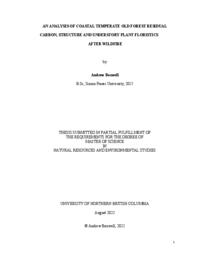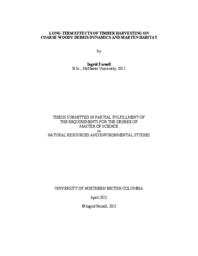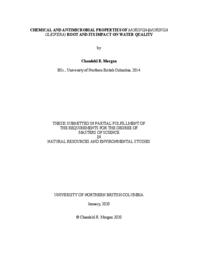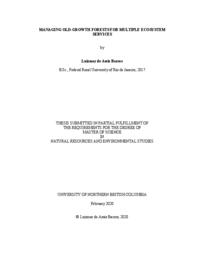Elkin, Ché
Person Preferred Name
Ché Elkin
Related Works
Content type
Digital Document
Origin Information
Content type
Digital Document
Origin Information
Content type
Digital Document
Origin Information
Content type
Digital Document
Origin Information
Content type
Digital Document
Description / Synopsis
Forest ecosystems and the ecological services they provide are complex and dynamic. Disturbance and successional processes impact habitat for animals such as caribou (Rangifer tarandus caribou Gmelin 1788, Banfield 1961, 1974) and moose (Alces alces L.). The forested winter habitat of the Tweedsmuir-Entiako caribou herd has been significantly affected by recent disturbance. In order to evaluate the mid- and long-term consequences for habitat, we require an understanding of how habitat attributes change as stand structure changes over time. I developed a framework to link a stand dynamics model (SORTIE-ND), via linker functions, to three ecosystem elements relevant to caribou populations: terrestrial forage lichen, moose forage, and vertical cover. I first used SORTIE-ND to model stand structure dynamics following mountain pine beetle (Dendroctonus ponderosae Hopkins) attack and clearcut harvesting. I developed linker functions and refined them with empirical data. These functions were applied to stand structure output from SORTIE-ND to project the response of habitat to the disturbance agents. I addressed three questions: 1. What is the influence of edaphic site on the provision of elements of caribou habitat over time? 2. What is the influence of stand type on the provision of elements of caribou habitat over time? 3. How do recovery trajectories of caribou habitat elements differ in response to disturbances such as mountain pine beetle and clearcut harvest? I found that site and stand type interacted to influence the suitability of terrestrial lichen, moose forage and vertical cover. Poor productivity sites were most favourable for terrestrial forage lichen. Higher productivity stands and broadleaf stands provided the greatest suitability for moose shrubs. Both mountain pine beetle attack and clearcut harvest improved stand suitability for lichen and moose browse though for different sites and stand types. Interestingly, I found that severe mountain pine beetle attack resulted in conditions that favoured forage lichen for longer than clearcuts. Clearcuts resulted in conditions that were more suitable than mountain pine beetle attack for winter forage for moose. When operating on landscapes with caribou winter habitat, forest managers should consider disturbance history, the distribution of sites and stand types, silviculture systems and the future desired state of ecosystem services. The SORTIE-ND modelling framework could be used to support the evaluation of alternative management decisions in caribou winter habitat including alternative silviculture strategies. This approach could also provide stand- and site-specific trajectories of the recovery of caribou habitat that could be applied to habitat supply models.
Origin Information
Content type
Digital Document
Description / Synopsis
Wildfires are a growing threat due to climate change, and they often leave unburned forest patches called fire refugia. While young forests in some regions burn more severely, preliminary observations in central British Columbia suggest that managed juvenile forests exhibit lower fire severity, potentially influenced by fuel moisture conditions, and stand characteristics. To identify the role of fuel moisture in the formation of juvenile stand fire refugia, this research collects and examines groundbased, empirically modelled, and remote sensing indices of greenness, moisture, and fire severity. This thesis investigates the fuel moisture contents (FMC) of duff, fine woody debris, and foliage at six locations near Prince George and Smithers, British Columbia (BC), over two summers (2021 and 2022). A total of 6116 individual samples of foliage, fine woody debris, and duff were collected from open, juvenile, and mature conifer forest stands and analysed for moisture content (MC). On average, the MC of duff and fine woody debris samples was higher in juvenile and mature forests than open sites. In contrast, open forests had higher foliage MC than the other forests. Observations of FMC were used to evaluate the accuracy of FMC estimates extracted from the Canadian Forest Fire Weather Index (FWI) system. Observations of FMC were also compared with remote sensing indices to assess the utility of using spaceborne (Landsat 8&9, Sentinel 2) remote sensing to predict local FMC. Three versions of the FWI model were used to estimate FMC: the original FWI model which uses the closest fire weather station, and versions that used updated parameters based on local fuel conditions and in-stand weather data. When estimating fine woody debris MC, the best statistical results are obtained with locally calibrated models at open stands. However, the original FWI model provides better estimates of duff MC in juvenile stands. For remote sensing of foliar MC in juvenile stands, the Normalized Difference Moisture Index (NDMI) had a higher R2 value (0.334) and a lower RMSE than other indices, while the NDMI gave the best result for foliar MC in mature forests (R2 = 0.160). For fine woody debris and duff MC in open stands, none of the remote sensing indices tested have R2 > 0.1 when estimating duff and fine woody debris MC. However, the RMSE of using empirical models from FWI to estimate duff (lowest at 59.95% RMSE) and fine woody debris (21.13%) MC was higher than remote sensing (41.64% for duff, 17.50% for fine woody debris). Remote sensing indices such as NDMI and GNDVI (Green Normalized Difference Vegetation Index) were used to estimate pre-burn FMC, and the estimated FMC results were found to be generally higher at juvenile stands than mature forest from a case study area from Plateau Complex Wildfire of 2017. Lower remote sensing estimates of FMC in mature stands corresponded to higher burn severities.
Origin Information
Content type
Digital Document
Description / Synopsis
I assessed some coastal temperature old-growth forests of southwestern British Columbia to understand their post-wildfire structure, carbon storage and biodiversity values. I used a remotely sensed relativized burn ratio and a composite burn index to compare measures of aboveground carbon, structural complexity and floristic diversity between burned and unburned reference plots years after four large wildfires. The unburned reference plots represented the natural range of variation of old growth values. In burned plots, 21 of 60 retained carbon values and 10 plots retained structural values similar to unburned old growth plots. There was an average of 12% floristic similarity between burned and unburned understory plant communities. For land managers, this method offers a way to compare old-growth values after wildfire in order to prioritize protection, salvage, and restoration options.
Origin Information
Content type
Digital Document
Description / Synopsis
Armillaria root disease, caused by the fungus Armillaria ostoyae (Romagn.) Herink, is an important agent of diversity in the forests of British Columbia. Forest operations can disrupt co-evolved host-pathogen balances, leaving behind a supply of carbohydrate-rich defenceless stumps, allowing for a post-harvest inoculum flush and disease spread. One management option is pre-harvest ringbarking, requiring the removal of a strip of bark, phloem, and cambium around a tree, in an attempt to limit carbohydrate transportation to the roots. In theory, ringbarking should deplete starch levels in roots prior to harvest, restricting A. ostoyae's energy base, directly limiting the pathogen, and indirectly increasing saprophytic competition and exclusion. I set out to determine if ringbarking Armillaria root disease centres in the forests of central BC prior to harvest would have a short-term influence on A. ostoyae's characteristic post-disturbance inoculum flush. My objectives were to quantify A. ostoyae colonization and starch content within the roots of ringbarked and untreated Douglas-fir (Pseudotsuga menziesii var. glauca (Mirb.) Franco (Beissn.) Franco). Thirty-six plots were established across three sites, with ringbarking randomly applied to eighteen plots. Sites were clearcut and sample stumps excavated. Armillaria ostoyae colonization was quantified by scoring disease severity of roots and by measuring percent colonized root lengths. Root samples were quantitatively analyzed for starch content. Logistic mixed models were used to assess incidence data, and linear mixed models to assess categorical measures of colonization severity, as well as intensive measures of colonization and starch content. No statistically significant differences were observed in post-harvest A. ostoyae colonization or starch content on roots from ringbarked trees versus untreated plots at any site or overall. My study was unable to confirm that ringbarking trees in Armillaria root disease centres prior to their felling influences starch content or colonization within root systems following harvest. My results combined with reviewed literature instead suggest that ringbarking may provide control through a host stress response mechanism. Additional long-term research is required to clarify the mechanisms of control and the effectiveness of treatment. Future work should address challenges surrounding initial disease assessment, treatment methods and timing, sampling, and the quantification of colonization and starch.
Origin Information
Content type
Digital Document
Description / Synopsis
Remote sensing techniques have been demonstrated to be efficient tools for producing reliable and accurate information regarding forest inventory. Airborne Laser Scanning (ALS) can be used to develop Predictive Ecosystem Mapping (PEM) models based on Digital Elevation Model (DEM) derived layers. These PEM models, and the variables that they are based on may be used to generate reliable information to predict forest growth potential using an age-independent approach. This study evaluated the efficacy of using ALS-derived attributes to infer Site Index (SI) in plantation areas up to 30 years old, and compares the results with the current Biogeoclimatic Ecosystem Classification (BEC) estimates. I used a machine learning approach and Random Forest techniques to develop an age-independent SI model (SI_pem) incorporating DEM-derived topographic layers. The resulting SI_pem model produces accurate SI estimates at a fine grain across different forest ecosystems. The model performed significantly better when compared to Site Index by Biogeoclimatic Ecosystem Classification site series (SIBEC) lookup tables. Microclimate variables associated with water process, such as Topographic Positioning Index, Diurnal Anisotropic Heating, Topographic Openness Dominance and Overland Flow Horizontal Distance had significant importance to predict SI across the three areas studied in this work.
Origin Information
Content type
Digital Document
Description / Synopsis
I evaluated how intra- and inter-specific competition affects the development of eleven wood attributes of trembling aspen (Populus tremuloides Michx.) and white spruce (Picea glauca (Moench) Voss) over 34 years. My analysis was conducted in a mixedwood trial site in Northern British Columbia, Canada, that included treatments consisting of 0, 1000, 2000, 5000, and 10000 stems per hectare of aspen. Competition was found to negatively influence wood attribute development in aspen and positively impact spruce (at low levels of competition). Plot level competition indices were the best predictor of variation in aspen wood attributes, while stand level competition (population density) best explained the majority of spruce wood attributes. Maintaining aspen at lower densities in intimate mixture can have a positive effect on spruce wood quality, while incurring relatively small reductions in spruce volume production and also retaining the ecological benefits associated with managing for mixed stands.
Origin Information
Content type
Digital Document
Description / Synopsis
At a long-term experimental trial in northern British Columbia, Canada, I analysed the impact of varying amounts of timber retention: 0% (clearcut), 40%, 70%, 100% (unharvested) on CWD volume, decay class, and inputs from windthrow over 27 years. I used attributes (diameter, length, decay class, and height above the ground) known to be favourable to marten to create an index for assessing the impact of harvesting intensity on CWD habitat features. I then used airborne laser scanning (ALS) to predict CWD volume, habitat value, and piece attributes over the landscape. Stands with 70% retention had CWD attributes that resulted in CWD habitat features similar to unharvested stands. Clearcuts contained pieces that were smaller, more decayed, and closer to the ground, which contributed less valuable habitat, compared to stands with higher retention. Windthrown trees were the majority of CWD inputs and volume change was positively related to percent retention.
Origin Information
Content type
Digital Document
Description / Synopsis
Forest management in the central interior of British Columbia has been active for over a century. Industrial forest practices in the region are based on the premise that harvest and subsequent stands regeneration is sustainable, but recent investigations raise questions about long-term ecological sustainability and impacts on biodiversity. I evaluate here, using a chronosequence of forest stands, the impacts of stand harvest on biodiversity status and recovery. Aerial laser scanning is used to enhance analysis and model impacts spatially. I provide a novel assessment of key biodiversity metrics of diversity, richness, abundance, and modeling using linear discriminant analysis and random forest frameworks. Results show that vegetation community composition and coarse woody debris (CWD), a key habitat for numerous taxa, are both impacted by harvest history. Predictive mapping of CWD provides insights and a further tool for decision makers to manage and ensure natural levels of CWD are maintained on the landscape.
Origin Information
Content type
Digital Document
Description / Synopsis
It is prudent to understand how tree growth responds to climate variability to better project their growth in the current and future changes in climate in boreal forests. In this thesis, I studied how climate variables influence individual white spruce trees (Picea glauca (Moench) Voss) over short and intermediate periods in pure and mixedwood stands in northeastern British Columbia. In Chapter 2, I studied the importance and the influence of annual, seasonal, and monthly microclimate variables on the annual growth of white spruce trees in pure and mixedwood stands. In Chapter 3, I studied the importance and the influence of microclimate variables on sap flow of white spruce trees through different time scales in these two stand types. My key finding in these two chapters is that stand composition and structure are essential determinants of how spruce radial growth and sap flow respond to fluctuations in climate variables, and how they will respond to projected future climate scenarios. A combination of warmer temperatures and drought during summer will negatively affect white spruce trees growth in pure and mixedwood stands in the studied region. Spruce sap flow in both stand types is likely to increase as the climate warms, increasing the demand for soil water. As this resource becomes less available, white spruce in both stand types are likely to respond with processes that can compromise their physiological integrity. White spruce growing in mixedwood stands might be more sensitive to drought stress than in pure stands due to the higher competition for limiting resources (primarily water). This thesis provides information of expected changes in tree growth to climate variability and demonstrates the importance of appropriate site selection to plant spruce trees and management of pure and mixedwood stands.
Origin Information
Content type
Digital Document
Description / Synopsis
Moringa oleifera is a tropical tree with nutritious, anti-inflammatory, and antimicrobial properties. Moringa seeds have been studied for their ability to purify water, however roots have not. This study identified the nutrient composition of Moringa roots grown in a greenhouse, and tested whether the roots improved water quality. Moringa roots were dried, powdered and added to contaminated water to test their impact on E. coli, pH, turbidity, and electrical conductivity. The chemical composition of Moringa roots were measured using ICP-MS. The five main elements observed were potassium, phosphorus, magnesium, sodium and calcium. None of the elements extracted were of health concern for drinking water quality. Electrical conductivity and pH remained within drinking water quality guidelines. Moringa root powder resulted in a significant increase in turbidity. Moringa concentration of 600 mg/L removed up to 87% of E. coli in water. Moringa root powder shows some potential as a point-of-use water treatment.
Origin Information
Content type
Digital Document
Description / Synopsis
I studied how microclimate variables influence the growth of white spruce trees (Picea glauca (Moench) Voss) in pure and mixedwood stands in north-eastern British Columbia. My key finding is that stand composition and structure are essential determinants of how spruce radial growth and sap flow respond to fluctuations in climate variables. A combination of warmer temperatures and drought during summer will negatively affect white spruce trees growth in pure and mixedwood stands in the studied region. Spruce sap flow in both stand types is likely to increase as the climate warms, increasing the demand for soil water. White spruce growing in mixedwood stands might be more sensitive to drought stress than in pure stands due to the higher competition for limiting resources (primarily water). I provide information that will be useful in modeling and managing these stands across western Canada under current and future climate conditions.
Origin Information
Content type
Digital Document
Description / Synopsis
Old-growth forest reserves offer the potential to facilitate the maintenance of multiple ecosystem services (ES), such as carbon storage, water and recreation, in managed landscapes. However, substantial challenges exist with regard to defining and identifying old-growth forests, and suitably locating priority areas for old-growth conservation. To address these issues, I developed a structure-based old-growth index using field and LiDAR metrics that allowed old-growth values to be estimated at a fine grain across a landscape. I then used a spatial prioritization tool to simulate old-growth reserves for multiple ESs. Using this framework I evaluated trade-offs between forest ESs including timber. This thesis contributes to the management of old-growth forests by providing a quantitative and repeatable framework to identify, assess and monitor old-growth values while indicating the scope for the establishment of old-growth reserves for multiple ESs.
Origin Information
















